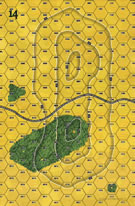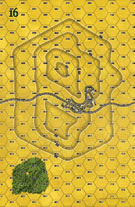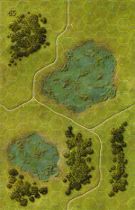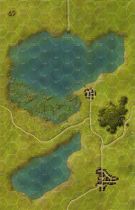|
Border Violation Power of the East #1 |
||
|---|---|---|
| (Attacker) Japan | vs | Soviet Union (Defender) |
| Formations Involved | ||
|---|---|---|
| Japan |  |
19th Infantry "Tiger" Division |
| Soviet Union |  |
118th Rifle Regiment |
| Soviet Union |  |
119th Rifle Regiment |
| Soviet Union |  |
40th Rifle Division |
| Soviet Union |  |
NKVD |

|
| Overall Rating, 4 votes |
|---|
|
2.25
|
| Scenario Rank: --- of 957 |
| Parent Game | Power of the East |
|---|---|
| Historicity | Historical |
| Date | 1938-07-31 |
| Start Time | 02:00 |
| Turn Count | 12 |
| Visibility | Night |
| Counters | 88 |
| Net Morale | 1 |
| Net Initiative | 2 |
| Maps | 4: 14, 16, 45, 49 |
| Layout Dimensions | 86 x 56 cm 34 x 22 in |
| Play Bounty | 173 |
| AAR Bounty | 154 |
| Total Plays | 3 |
| Total AARs | 3 |
| Battle Types |
|---|
| Hill Control |
| Surprise Attack |
| Scenario Requirements & Playability | |
|---|---|
| Eastern Front | Counters |
| Guadalcanal | Counters |
| Power of the East | Base Game |
| Road to Berlin | Maps |
| Sinister Forces | Counters |
| Introduction |
|---|
|
As tensions between the USSR and Japan grew throughout the 1930s, many considered a war between the two powers inevitable. The expectations edged closer to reality when Soviet border troops occupied the heights "Bezymyannaya" and "Zaozyornaya" in July 1938 and began to construct fortifications on them. The USSR, Japan and Manchuria (the latter occupied by Japan) all claimed this territory on the border. Therefore, on July 15th the Japanese ambassador to Moscow demanded the immediate withdrawal of Soviet troops from the heights, pretending the seizure violated Manchurian territory. When this expostulation was just as resolutely rejected by the Soviet government (which claimed the opposite to be true), the Japanese military decided to enforce their demand by the force of arms. |
| Conclusion |
|---|
|
The first Japanese attack on July 29th had been repelled by a small group of Soviet border guards consisting of only 11 men (which were later reinforced by regular units). Nevertheless, two days later, on July 31st two full-strength Japanese infantry regiments attacked the disputed heights by night and took them in a valiant close assault. The bayonet charge as carried out in this action became a model for all other Japanese charges throughout World War II. Despite being successful this time due to darkness and the element of surprise, in many later cases this practice led to nothing other than high casualties for the attacker. The Soviet border troops, supported by regular army units, did everything they could, but were eventually overwhelmed and forced to retreat from the heights. Characteristic of the overall confusion, a reinforcement company of the Red Army arrived at the battlefield without any ammunition, as their commanding officer suspected the whole affair to be only a routine practice alarm. |
| Additional Notes |
|---|
|
Maps 45 and 49 come from the non-series game Infantry Attacks: August 1914. |
| AFV Rules Pertaining to this Scenario's Order of Battle |
|---|
|
| 2 Errata Items | |
|---|---|
| Scen 1 |
In the order of battle, the INF (NKVD) units should be RIF (NKVD). (rerathbun
on 2011 Aug 22)
|

|
The reduced direct fire value in Kursk: Burning Tigers is 4-4. (plloyd1010
on 2015 Jul 31)
|
| Asaltos sin cuartel en el lago Khasan | ||||||||||||
|---|---|---|---|---|---|---|---|---|---|---|---|---|
Este escenario reproduce la batalla nocturna que se produjo a orillas del lago Khasan, en la frontera entre Manchuria y la URSS, el 31 de julio de 1938. En este combate dos batallones de infantería japonesa atacan dos colinas defendidas por una exigua fuerza de guardas fronterizos de la NKVD e infantería del Ejército Rojo. La escasa fuerza fronteriza se ve paulatinamente reforzada con la llegada de más infantería e incluso dos pelotones de tanques T-26. Este escenario no está bien desarrollado, ya que una de las pequeñas columnas de refuerzo soviéticas que entra en el campo de batalla una vez iniciada ésta no puede llegar a su objetivo antes del final de la partida. Esto la convierte en completamente inútil para el resultado final. No obstante esta deficiencia, el escenario es interesante ya que muestra unas condiciones poco habituales en los escenario de PG. En efecto, la batalla se desarrolla en su integridad en noche cerrada con visibilidad de apenas un hex, en una de las colinas completamente cubierta por campos de cultivo, y los soviéticos ven su potencia de fuego -de por sí ya muy disminuida por la nocturnidad y el combate en colinas- mermada por la escasez de municiones. En estas condiciones, la partida no admite muchas florituras tácticas. Los japoneses se limitan a asaltar toda unidad enemiga con la que se encuentran, conscientes de su superioridad moral y en el combate a corta distancia. No obstante, los soviéticos -especialmente las unidades de la NKVD- ofrecen una resistencia tenaz. Los japoneses consiguen desalojar por completo a los soviéticos de la colina sur, aunque después algunas unidades de refuerzo consiguen infiltrarse entre las defensas japonesas. En cambio, en la colina norte la resistencia soviética consigue desbaratar en dos puntos las desesperadas cargas japonesas y mantenerse en sus posiciones hasta el final de la partida, con lo que obtiene la victoria por muy escaso margen. La partida ha sido muy interesante y disputada. La habría valorado con una "cuatro" de no ser por el error del diseñador al hacer ineficaz la entrada de parte de los refuerzos soviéticos. |
||||||||||||
| 0 Comments |
| Aren't we dead yet? | ||||||||||||||
|---|---|---|---|---|---|---|---|---|---|---|---|---|---|---|
In previous and never completed AAR, I was going to say that I don't like blame my defeats on bad luck. Here I will say, don't like to credit my victories to good luck either, but I did have very useful luck. That said, this scenario required good play on my part, a critical blunder on my opponent's, plus the a fore mentioned good luck, to barely eek out a victory. This play imbalance is part of the reason for the low rating I gave. A second reason is the reinforcement march times do not seem have been well calculated. (Konstantin, I hope you take this as constructive, because that is how I intend it.) The marches are critical in 2 instances. First the reinforcing T-26, using the standard TEC, only just has time to make the edge of the southern 40-meter hill. That makes for a very gamey snatch/deny victory situation (I don't like that). The second reinforcement issue is the unarmed arriving infantry. Flat-out, between the lakes and around the woods, they get to the base of the northern hill. This makes them an interesting footnote, and completely useless. Add in FoW, with its 4.8% chance at night, odds are the hill guys will be on their own. Criticism done, on to what happened. The far north group set on the edge of the northern most hill. Far south on the edge of the woods. The 2 more central groups were on the elevation lines in their respective start zones. The Japanese came on in 2 roughly equal groups, aimed at the northern groups on each hill. (This contributes the critical blunder.) On turn 2 the southern Jap group reaches the northern south hill position, on the northwest hex. This is what gave me small chance to make a fight of the scenario, and completes the blunder. My southern south hill group rushes to the aid of the northern south hill position. The southern north hill position is also moving to help, and will arrive a couple turns later. Meanwhile the northern Jap group is slogging through the massive hill-field. The Japanese reinforcements arrive very late, turn 4. The, now larger, south hill position with stands the first rush against it (important luck here, along with the uphill defense and some first fire). I inflict causalities, cause some demoralizations and generally discombobulate the Japanese attack, for the moment. in the debit side my reinforcements are delayed due to FoW. About turn 6, I feel like the outlaws in Robin Hood: Prince of Thieves. I beat the first rush, but now the Japanese are recovering and have more guys. The plan shifts to delay, then make them chase me around the hill. The north Japanese finally reach me. A lucky op-fire demoralizes the Lt-Col leading the charge, that buys me turn. After that the first position starts to crumble. The second position moves to cover the previously hidden tank & NKVD movement. More FoW terminations occur. At this point they help me more than my opponent. A reduced NKVD & ING, and HMG have evaded the massacre in the south. The small force which as on the west side of the northern hill has moved onto its southern tip. It is turn 10, the Japanese don't have time to mop me up anymore. I win! Sheesh! |
||||||||||||||
| 1 Comment |
Hi Peter,
thank you very much for your well thought-out comment, I found it very interesting to read.
I have to admit that you are completely right, the delayed arrival of the unarmed infantry is obviously an ommission on my part. I cannot remember how this could happen. Maybe I did some changes and forgot to adjust the entry time of the reinforcements. Anyway, such things simply shouldn't happen.
But there is a way to fix it without changing the scenario: you could simply use the "Strategic Movement" optional rule Nr. 17.3. This will ensure that the reinforcements arrive just in time to take part in the battle.
The implimentation of this rule should also help to asjust any problems with the game balance. Remember that even a single one, even demoralized, soviet unit will ensure a soviet victory. Yes, I know, this sounds rather gamey. But in reality the Japanese numerical superiority was even bigger than in this scenario, so I don't think that the defenders had any chance to stop them. So in my opinion this is the only way to give the soviet player a chance to "win".
Nevertheless it sounds that you had a very close and interesting game. So I sincerely hope that you had fun playing this one and that you don't regret it.
If you try other scenarios from "PotE", please let me know, how you find them. I am looking forward to hear from you!
Best,
Konstantin
| Too many special rules, scenario too scripted | ||||||||||||
|---|---|---|---|---|---|---|---|---|---|---|---|---|
I really didn't like this one. Too many special rules and caveats, not enough player input. The turns, maps and victory conditions lead to a dash and do the math scenario. |
||||||||||||
| 0 Comments |

 PoSt010
PoSt010 

























